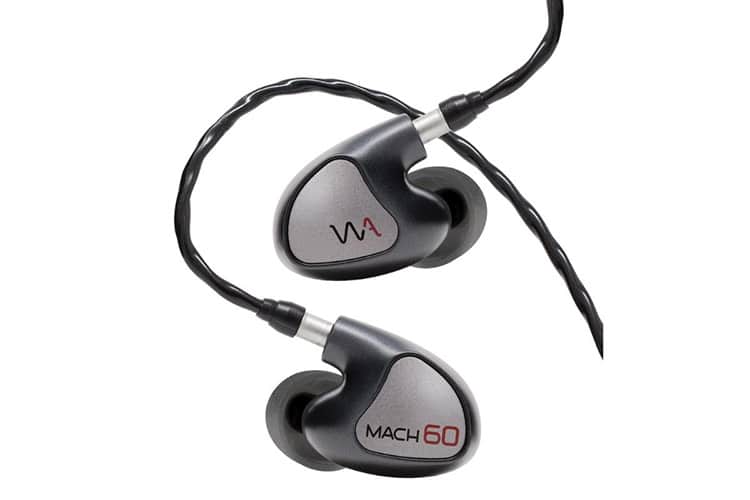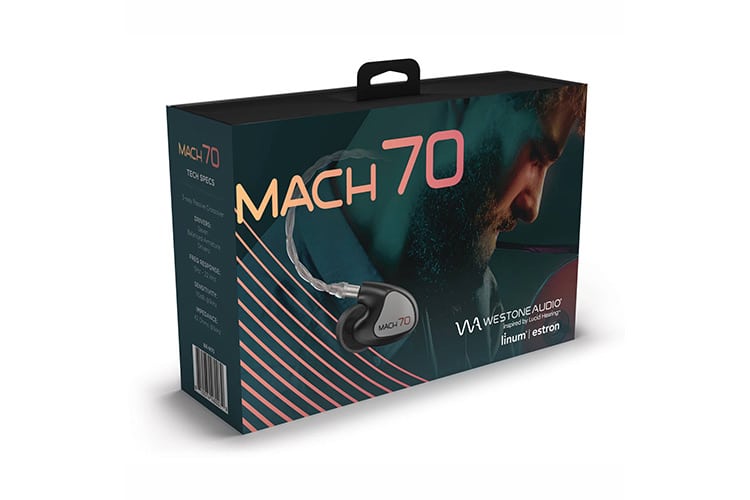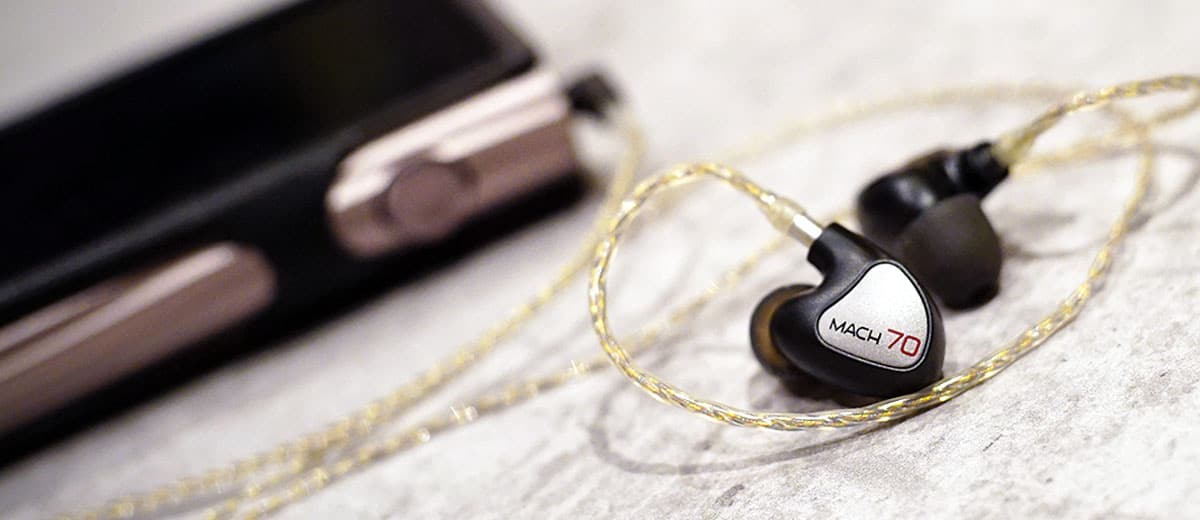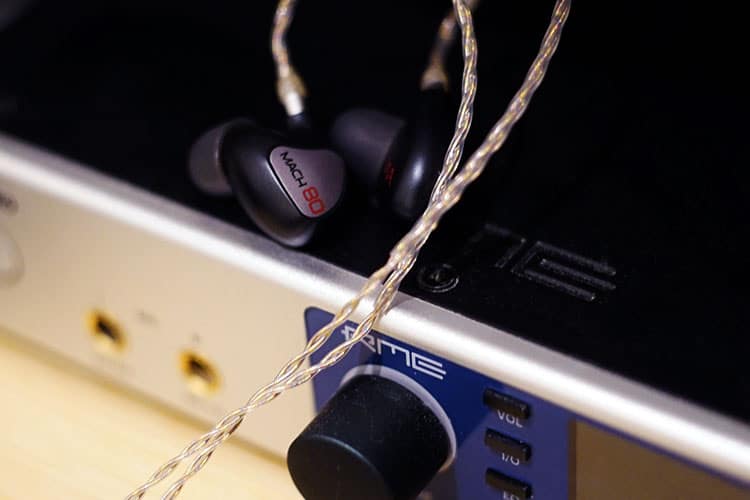Synergy
Efficiency
The MACH 70 measures 42Ω in impedance and 110dB SPL in sensitivity, which makes it quite a bit easier to drive than the bigger brother MACH 80.
On dongles, laptops, and iPads not only the bass gets fuller, but there is also a decent definition with a good response speed. The background is very quiet despite the fact that bass frequencies are uplifted.
Power
The tonality is quite consistent with different sources. Stronger DAPs will offer the bass a higher level of control and refinedness, and also enhance the balance between different frequencies. On dongles or straight out of the phone the MACH 70 sounds pretty resolving and dynamic though the staging is more confined.
There is good room for the performance to scale up with better decoding and power, especially with an amplifier. Testing on the FiiO K9 Pro ESS and the Soncoz SGA1 on my desk the MACH 70 sounds more opened up and tranquil with the texture in the bass also being boosted.
The treble tuning that is slightly on the shy side can also adapt to higher power well and sound more exciting with powerful DAPs and amplifiers.
Pairings
Testing on the RME ADI 2 Pro, the MACH 70 leans slightly to the lower end and is very rounded and controlled. Quite a lot of details are unveiled in the midrange frequencies and the treble has a neutral presence that does not stress the transients.
It is quite easy to get the MACH 70 to sound dynamic and dense on this combo. There is good coherence and control in the treble that works well for audiophile tracks appreciation and movies.
Switching the MACH 70 to the Luxury & Precision W2, the sensitivity on MACH 70 as well as its intensity in bass complements the power of the dongle to sound strong in bass and very smooth in the frequencies. Beyond that, the coloration is more relaxing.
Though the dynamic is not as strong as on desktop gears it is engaging enough. There is also sufficient resolution to pull instruments from each other and define the vocal image clearly.
Using the FiiO M11 Plus ESS, the transient in the treble is strengthened and the bass is energized to attack speedily. This is a smooth-sounding combo that is suitable for EDM and synthesized music. It works well for streaming content as well to sound dynamic and immersive.
There is still a good sense of calmness with the fast decay and controlled treble, but I would prefer lifting the treble slightly for more excitement.
Select Comparisons
Westone Audio MACH 80
$1399
Technical
The MACH 70 and MACH 80 are differed by 1 bass driver and although they may look alike on paper, the different impedance and sensitivity numbers lead to a different response from matched gears in practice.
The MACH 70, being more sensitive in this case can be driven easier and is more friendly with portable sources, having its tuning onboard optimized for such pairings such that strong dynamics and clarity are achieved.
Design
The two IEMs are basically identical in design right down to a similar stock cable. You could only tell them apart by looking at the metallic faceplate where the model number is printed.
Performance
The two top models from Westone Audio this time are distinctively positioned and are different in tuning from each other, with different responses to power and gain. The coloration is much stronger on the MACH 70 which could easily recall your memories of the earlier Westone flagships with immersive bass.
The way how space is rendered on the two IEMs is also quite different. The MACH 80 emphasizes separation and harmony, spacing out every element from each other and allowing more details to be heard.
The MACH 70 keeps everything intimate. There is good attention to definition, instruments are swiftly communicating with each other and the music flow and articulation is very enjoyable with genres of music that need a stronger dynamic.
The MACH 80 is flatter and perhaps more boring in tuning to some without stressing some frequencies for clarity and boosting the dynamics. This allows good room for it to be paired with highly colored gears as well as for monitoring purposes.
Listening carefully the bass on the MACH 80 has a stronger sense of control and sounds more detailed. The MACH 70 on the other hand, is more vividly tuned, sounding more engaging and fuller in energy. The treble has quite a bit of resemblance to the MACH 80 probably due to similar drivers being used as the tweeters.
The cleaner, flatter presentation on the MACH 80 would be ideal when paired with professional gears such as mixing consoles or interfaces for monitoring or mixing. While the MACH 70 is more fun and engaging for music and could be easier powered by portable players and dongles.

Westone Audio MACH 60
$1099
Technical
The MACH 60 has a dual low, dual mids, dual treble BA drivers configuration and a different stock cable that is stealthier than the premium cables on MACH 70 and 80.
You will also notice the frequency response is not as wide measuring 8Hz to 20kHz, and the sensitivity is 100db @1kHz with a 35Ωimpedance rating. This is more like the MACH 80 than the MACH 70 which is more sensitive and allows its tonality to be consistent on different outputs.
Design
There isn’t much difference that I could tell, except for the logo on the metallic faceplate as well as the different stock cable. If you have sharp eyes you may have noticed the different color scheme, where the MACH 60 has a slightly lighter grey finish, but overall, it is well built like the MACH 70 and identical in size.
Performance
In practice, the MACH 60 feels slightly less sensitive than the MACH 70 and the tuning approach is more similar to the MACH 80 which is even, flat, and transparent.
In a similar manner to the MACH 80, the MACH 60 would require more power than the MACH 70 to sound firm and dense, yet it maintains an uncolored response that does not sound veiled or hollowed out even with dongles or the phone output.
Technically, the detail retrieval level is slightly stronger on the MACH 70, especially in the upper register, which is also more extended, opened up, and feels stronger in treble intensity. The MACH 70 is also more sensitive to power which at the same time makes it sounds more transparent if you are using dongles and laptops to power it.
Side by side the MACH 60 is pretty much a chamber music version of the MACH 80 that is designed to serve music with grand stages, both are great for monitoring purposes and classical music.
The MACH 70 doesn’t sound as linear and is ideal for rock shows and voices of powerful virtuosos, which require stronger bass, and a rhythmic midrange presentation.
Shanling ME800
$779
Technical
The ME800, the flagship IEM model from Shanling has a 6-driver configuration but instead of using just BAs the ME800 packs in dual dynamic drivers and 4 BAs.
A pair of toggle switches can be found on the side of the ME800 which allows users to tune up the bass with a total of 4 different tuning combinations available. The ME800 is quite sensitive with only 16Ω in impedance and 112dB SPL in sensitivity.
Design
The ME800 takes the form and design of custom monitors made from resins and has a deep, mystic swirl pattern on the faceplate. There are stronger audiophile appeals on different parts of the design, such as the metallic nozzle and cable parts, which make the appearance more premium.
The ME800 offers more functionality with the tuning switches, which seem to have enlarged the housing size. In comparison, the MACH 70 is much sleeker, lighter, and industrial in design.
On the cables of the ME800, an interchangeable design is offered which allows users to switch between different balanced terminations and single-ended connections.
Only a 3.5mm connection is offered on the MACH 70’s stock cable option which aligns with professional audio and mainstream standards but might be lacking for audiophile standards.
Performance
With two dynamic drivers handling the lower register and the midrange, the ME800 has a warmer and smoother presentation than the MACH 70, though it is not as resolving and layered. Using the stock balanced configuration on the ME800, the bass kicks strong and the midrange is full-bodied.
Testing with drumming tracks, the response speed is faster on the MACH 70 which makes it more accurate and controlled in tone. The ME800 sounds bigger in bass and thicker in its delivery. It is much more colored than the MACH 70 which drags down the speed slightly but may give vocals more favorable tonal quality.
The upper mids to the treble region on the ME800 is elevated to push forward clarity and strengthen the transients. It works really well for pop and string instruments.
The MACH 70 sounds more polished and less altered and is able to cope with a more intense treble presence in the music and interpret treble-intensive instruments more faithfully.
It is also noticeable that the ME800 is more sensitive in terms of loudness, but it will still require some good power for the dynamic drivers to sound expansive and dynamic.
The MACH 70 is less sensitive on paper actually sounds as dynamic and clear on dongles and has more room for the bass to sound fuller when there is more power from the source.

Our Verdict
The Westone Audio MACH 70 is an absolute joy to wear and it is definitely not a boring IEM hearing its strong technicalities and deep, immersive bass. Westone Audio could have named it a bassy version or something but they don’t, somehow justified by the strong performance in the upper register that isn’t covered by the bass lift.
Considering the very compact bodywork, the fullness it brings into the low end all the charm in the midrange and treble taken from the MACH 80, this co-flagship alternative is pretty much everything you could want on a traveler IEM.
Westone MACH 70 Specifications
- 3-way Passive Crossover
- Drivers: Seven Balanced-Armature Drivers
- Frequency Response: 5Hz – 22kHz
- Sensitivity: 110dB @1kHz
- Impedance: 42 Ohms @1kHz





